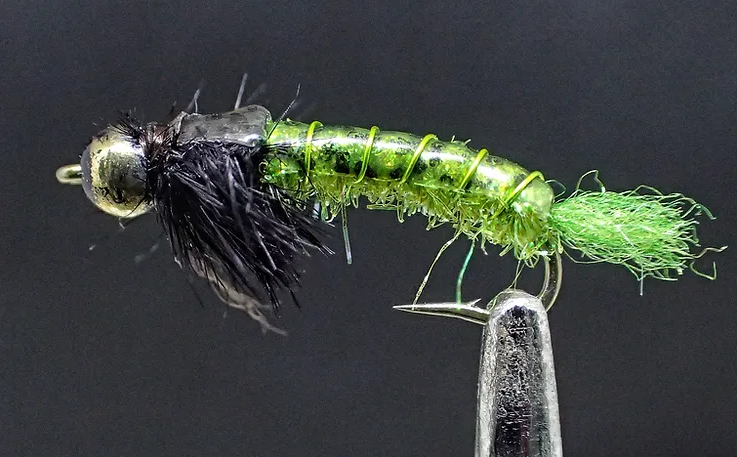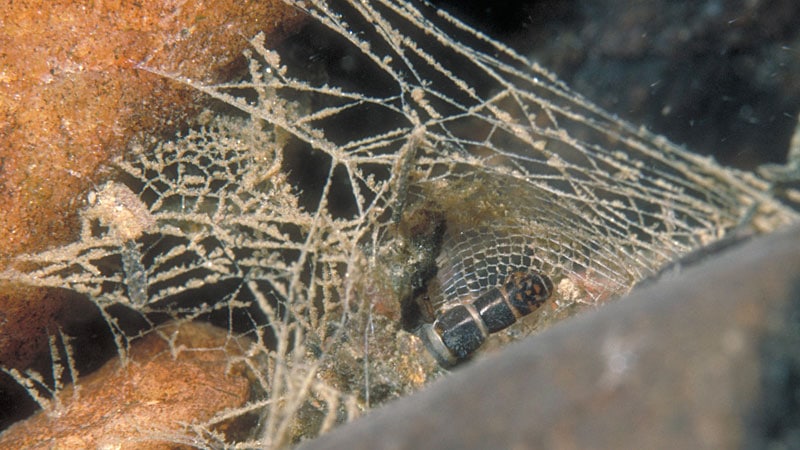Net Spinning Samaritans
Recent findings now reinforce what LaFontaine first introduced—caddisflies are more important than we first thought!

February 2021
Gary LaFontaine knew there was something special about caddisflies when writing his 1981 book on the subject; you can still see the ripple effects from it in how we fish today. If you haven't taken a look for yourself, you should check it out. Recent findings now reinforce what LaFontaine first introduced—caddisflies are more important than we first thought! Stream scientists have evidence that suggests net spinning caddisflies actually prevent scouring and erosion when they construct their silk webs. These nets are strong enough to prevent losses to streambed habitat despite flooding, high runoff, or sporadic dam releases.
Is this all a little confusing? Let's fill in some blanks. First, caddisflies come in several varieties. You're probably already aware that unlike stoneflies and mayflies, caddisflies undergo complete metamorphosis (i.e., their life cycle includes four stages: egg, larva, pupa, and adult). This life cycle involves eggs developing into larva, then pupating and drastically transforming before reaching adulthood. But during their aquatic larval stage, caddisfly species take on varying strategies to collect and find food. Whether they shred leaves, graze on the algae growing on rocks, actively hunt prey, or passively collect materials drifting downstream, each strategy has resulted in the various forms that we see in caddisfly larvae. And each feeding strategy can lead to different behaviors. Predatory caddisflies are usually free-living, as they roam for prey. If a caddisfly grazes for food, they likely have to build a case around their body to provide ballast, structure, and protection as they search out food. Some even construct nets to gather fine particulates drifting downstream, passively collecting their food.

These net builders, including the genus hydropsyche, are the group responsible for stabilizing the stream bottom. Alone, one net might not make a difference, but hydropsyche are so widespread that the number of nets built within the interstitial rock space on the streambed together anchor large patches of sediment from scouring. In laboratory experiments, research has shown that if 87 of 100 pebbles were to become mobile at an increase in velocity for a stream where no net builders were present, that same stretch with net building caddisflies, would only lose 13-50 of those same 100 pebbles. This is because during the net spinning process, they string together several larger grains, increasing the force needed to move all of the objects together (rather than one object on its own). Their silk is strong enough to even anchor cobbles as large as oranges! Not only do caddis nets glue sediments and substrates together, they also reduce the flow surrounding their nets. Though on a local scale, these reductions in flow can lead to greater habitat availability for all local macroinvertebrate species. This habitat stability can maintain stream communities despite drastic flow events. Additionally, caddisflies may construct new nets and abandon old nets, while the old nets continue their efficiency at moderating scouring and erosion. Finally, due to the increased resilience to flooding, the patchwork of nets can keep easily transportable fine particles, like silt, from becoming mobile and eroding other substrates further downstream. When an excess of fine particles settle, they often fill those spaces between larger sized sand, and cobble, making it harder for oxygen to travel between the rocks and hindering macroinvertebrate and trout-rearing habitats. Though hydropsyche are found in all types of freshwater environments, their abundance below dams has interesting implications for maintaining streambed habitat despite large or abrupt flow releases.
When animals reshape their surrounding environments in such a noticeable way, they are referred to as ecosystem engineers. Recognizable stream ecosystem engineers include beavers, spawning salmon, humans, and now, net spinning caddisfly larva. With the exception of people, removing any of these keystone species from a river could drastically change a river's health. This goes to show how even the smallest, most nondescript organisms can disproportionately shape our streams.
Check out the Stroud Water Research Center's video about the net spinning caddisfly larva for more visuals and information.

Sources:
- Cardinale et al. 2004. Net spinning caddisflies as stream ecosystem engineers: the influence of Hydropsyche on benthic substrate stability. Functional Ecology, 18.
- Denver Post. 2012. South Platte River bounces back for fly-fishing after Hayman Fire. https://www.denverpost.com/2012/05/14/south-platte-river-bounces-back-for-fly-fishing-after-hayman-fire/
- Stroud Water Research Center. 2020. Caddisflies, Engineering an Ecosystem. https://stroudcenter.org/virtual-learning-resource/freshwater-rockstar-net-spinning-caddisfly/
- Spence & Hynes. 1971. Differences in Benthos Upstream and Downstream of an Impoundment. Journal of the Fisheries Board of Canada, 1.
- Macguire et al. 2020. Retreat but no surrender: net-spinning caddisfly (Hydropsychidae) silk has enduring effects on stream channel hydraulics. Hydrobiologia, 847.



